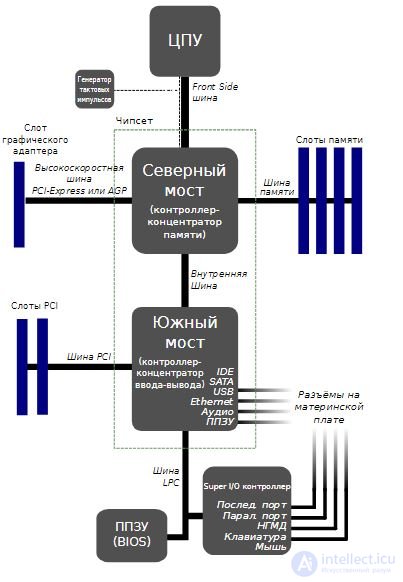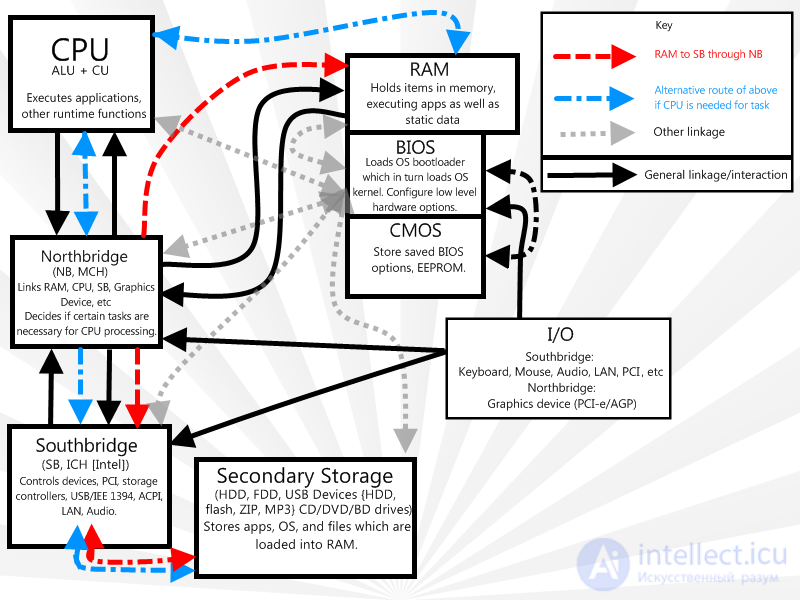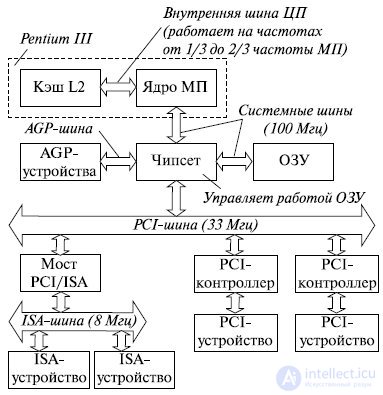Lecture
Chipset (eng. Chipset ) - a set of chips designed to work together to perform a set of specified functions.
Thus, in computers, the chipset placed on the motherboard plays the role of a connecting component (bridge) ensuring the interaction of the central processor (CPU) with various types of memory, I / O devices, controllers and PU adapters, directly through itself (and having some of the in their composition), and through other controllers and adapters, using a multi-level bus system. [1] Since the CPU as a rule can not interact with them directly. The chipset determines the functionality of the motherboard. It includes the processor bus interface and ultimately determines the type and speed of the processor used. Determines in many respects the type, volume, speed and type of supported memory, the operating frequencies of different buses, their capacity and type, support for expansion boards, their number and type, etc. So on. The chipset is one of the most important components of the system, largely determining its speed, expandability, stability under various settings and conditions, upgrading, application, etc. Being essentially the basis of the platform / motherboard, [2] chipsets are found and in other devices, such as cell phones and network media players.
In the modern sense, this term appeared in the mid-1980s. The pioneers were the Amiga series of computers with the OCS chipset (later replaced by ECS and AGA). A little later, Chips & Technologies proposed the CS8220 chipset (main chip 82C206) for IBM PC / AT-compatible systems. At about the same time, the Atari ST series computers, also created using the chipset, appeared.
The development of Soviet computing technology, with existing distinctive schools (Glushkov, Lebedev, Petrov, Ershov, Abramov, Brusentsov, Kalyaev, Shura-Bura, etc.), was significantly influenced by the successful development of foreign microelectronics, primarily American. The specific use of computer technology in the USSR and its development have played a role in the development of domestic "chipsets" - they are the so-called "chipsets" and "microprocessor kits". Considering the state of development of technologies at the time of the collapse of the USSR and subsequent events in the country, there is currently a noticeable outweigh of theoretical developments over practical ones in Russia.

Schematic representation of a traditional motherboard chipset
Most often, the chipset of motherboards of modern computers consists of two main microcircuits (sometimes combined into one chip, the so-called system controller hub (English System Controller Hub, SCH)):
Sometimes the chipset includes a Super I / O chip that connects to the south bridge via a Low Pin Count bus and is responsible for low-speed ports: RS232, LPT, PS / 2.
There are also chipsets that are markedly different from the traditional scheme. For example, for LGA 1156 processors, the north bridge functionality (connection to the video card and memory) is fully integrated into the processor itself, and therefore, the LGA 1156 chipset consists of one south bridge connected to the processor via the DMI bus [7].
The creation of a full-fledged computing system for a personal and home computer based on such a small number of chips (chipset and microprocessor) is a consequence of the development of technological processes of microelectronics developing according to Moore's law (see the history of computing technology).
In the creation of chipsets, providing support for new processors, first of all are interested manufacturers of processors. Therefore, the leading manufacturers of processors (Intel and AMD) produce test kits (the so-called English reference chips) especially for motherboard manufacturers. After running on such chipsets, new series of motherboards are released, and as the licenses move to the market (and given the globalization of global manufacturers, cross-licenses) are issued to different manufacturers and, sometimes, subcontractors of motherboard manufacturers.
The list of major manufacturers of chipsets for x86 architecture:

Chipset Functions
Chipset (chIPset) is a set of LSI (usually 1-3 chips), functionally equivalent to the chips included in the standard configuration of the microprocessor system.
Typically, a chipset integrates the functions of the following devices:
Usually in the composition of the chipset emit:
The choice of chipset largely determines the configuration of the IPU and its performance. If the MP can be replaced, and the capacity of the RAM is increased, then the replacement of the chipset is unambiguously connected with the replacement of the motherboard, and the limitations of the chipset also uniquely limit the possibilities of replacing other MPS elements: MP, RAM, external devices.
The chipset imposes restrictions on the following functional characteristics of the system as a whole: memory type, cache type of the second and / or third level, MP type, maximum system bus frequency, PCI bus type (32-bit or 64-bit); support for multiprocessor configuration and some other features.
Practice shows that the difference in performance of motherboards from different companies built using the same chipset is up to several percent, whereas the same parameter for different chipsets can differ by an order of magnitude.
Consider the use of a chipset using the example of organizing a microprocessor system based on the Pentium III MP on the Katmai core (Fig. 8.7).

Fig. 8.7. The structure of the microprocessor system using a chipset
The PCI bus frequency is 33 MHz and at the system bus frequency of 66 and 100 MHz (the division of the frequency by 2 and 3, respectively) is used. AGP (Accelerated GraphiCS Port) - 32-bit bus (clock frequency is always 66 MHz), used to connect the graphics adapter and allows you to speed up the exchange of data between the graphics adapter and the main memory. In AGP mode, the 2x effective frequency is 133
MHz is provided using both edges of 66 MHz frequency pulses. The ISA bus operates at 8 MHz. Its operation is the responsibility of the PCI / ISA bridge, which is a regular PCI device (just built into the chipset).
The system bus can operate at different frequencies, but all of these options are wired and electrically compatible, which creates the ground for overclocking.
Thus, when changing the system bus frequency, for example, from 66 to 100 MHz, only three devices are subject to replacement: a processor, a chipset and a memory. No other devices will notice a change in the bus — neither AGP video adapters, nor any of the PCI controllers, nor the old ISA cards. This is the fundamental difference between the 100 MHz bus and the 66 bus.
MHz, overclocked to 75/83 MHz. In the first case, the new chipset provides PCI at a frequency of 33 (100/3) MHz, in the second, the old chipset does not even suspect “overclocking” and continues to divide the system bus frequency by 2, and as a result, the PCI bus frequency is 37.5 or 41.5 MHz, which may cause some PCI devices to malfunction.
For systems using ARM processors, chipsets were also created. And if the first samples (such as ARM2 for Acorn Archimedes consisting of the actual processor and IOC, MEMC, VIDC, VIDC20 and later ARM3 chips) were generally similar to their current IBM PC chipsets, then modern ones (such as Qualcomm Snapdragon and Texas Instruments DaVinci), due to its focus on mobile devices, differs markedly in both structure and technical features.
Comments
To leave a comment
Computer circuitry and computer architecture
Terms: Computer circuitry and computer architecture